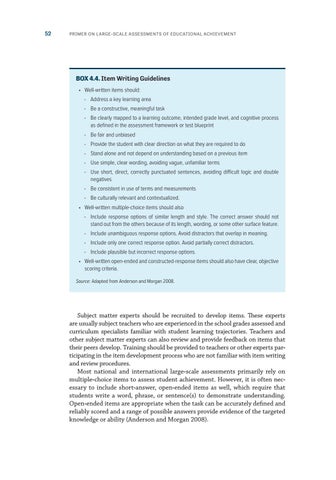52
PRIMER ON LARGE-SCALE ASSESSMENTS OF EDUCATIONAL ACHIEVEMENT
BOX 4.4. Item Writing Guidelines • Well-written items should: • Address a key learning area • Be a constructive, meaningful task • Be clearly mapped to a learning outcome, intended grade level, and cognitive process as defined in the assessment framework or test blueprint • Be fair and unbiased • Provide the student with clear direction on what they are required to do • Stand alone and not depend on understanding based on a previous item • Use simple, clear wording, avoiding vague, unfamiliar terms • Use short, direct, correctly punctuated sentences, avoiding difficult logic and double negatives • Be consistent in use of terms and measurements • Be culturally relevant and contextualized. • Well-written multiple-choice items should also • Include response options of similar length and style. The correct answer should not stand out from the others because of its length, wording, or some other surface feature. • Include unambiguous response options. Avoid distractors that overlap in meaning. • Include only one correct response option. Avoid partially correct distractors. • Include plausible but incorrect response options. • Well-written open-ended and constructed-response items should also have clear, objective scoring criteria. Source: Adapted from Anderson and Morgan 2008.
Subject matter experts should be recruited to develop items. These experts are usually subject teachers who are experienced in the school grades assessed and curriculum specialists familiar with student learning trajectories. Teachers and other subject matter experts can also review and provide feedback on items that their peers develop. Training should be provided to teachers or other experts participating in the item development process who are not familiar with item writing and review procedures. Most national and international large-scale assessments primarily rely on multiple-choice items to assess student achievement. However, it is often necessary to include short-answer, open-ended items as well, which require that students write a word, phrase, or sentence(s) to demonstrate understanding. Open-ended items are appropriate when the task can be accurately defined and reliably scored and a range of possible answers provide evidence of the targeted knowledge or ability (Anderson and Morgan 2008).

